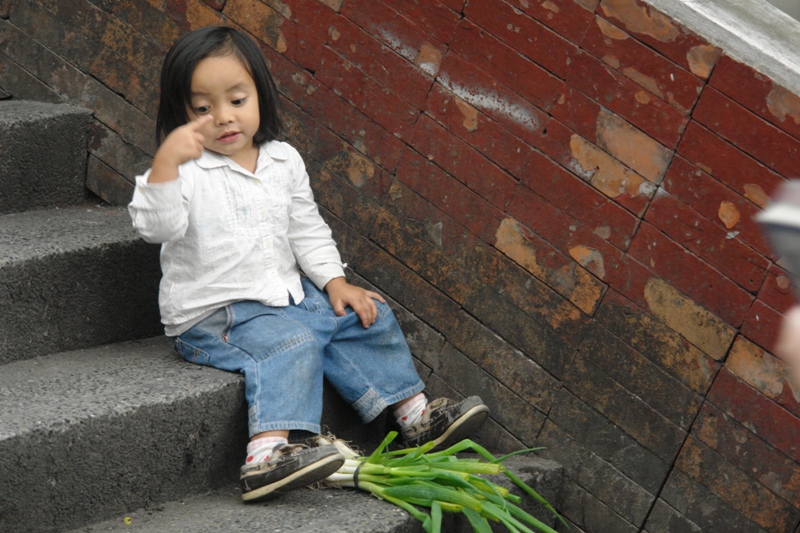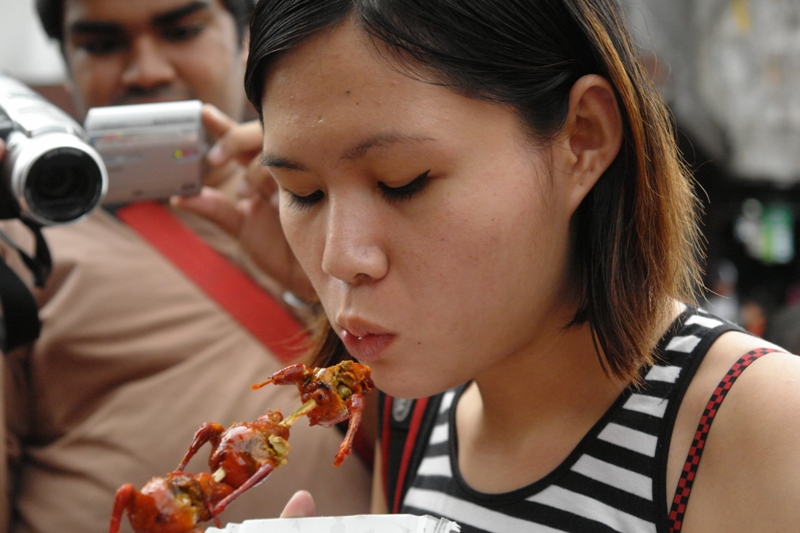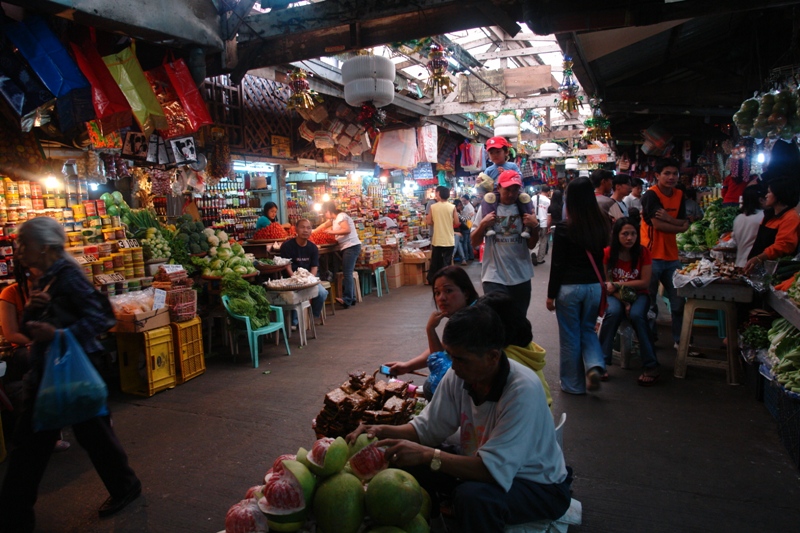Tuesday, December 18, 2007
Day 7: Back to Baguio
Although Feeza thought that the journey back was terrible and when we reached Baguio the dust was worst than Sagada, deep in all of us we had the same four words as Feeza.
“I miss Sagada already.”
Back in Session Road, Baguio, Aron was contented.
“Finally I ate a fine Chinese meal at Chow King! (Spicy Fried Rice with siomai)”
For Pooi Yarn, having Spicy Wanton Noodle Soup for the first time since arriving in the Philippines really made her miss home.
Jasmine Chew indulged in the FTV (Fashion TV) Channel and shopping at SM Mall. Meanwhile, some of the others shopped at the local market.
Maxine and Zeck loved the market. “A shopaholic’s paradise! Better learn to bargain and bargain fast!” Maxine’s bargaining skills could be heard from a couple of stores down the alley. “There are so many things to buy at the market and I’m into indigenous stuff so it’s a perfect place for me to go!” says Zeck displaying a new collection or so every day or two.
After a long search, Linda even found the Balisong knife she had been looking for! However, Max Tan has a piece of advice for all travelers here:
Max: “It’s dangerous to shop in Baguio. There are many imitation goods.”
Some people: …
…went for night entertainment at night...
For Grace and Jojo, it was their first time seeing male strippers.
“Interesting…” Grace definitely saw much more than she counted on.
Jojo spent her 21st birthday there. She felt the guys-in-underwear were “so close to her”.
That same night, Susan thought she was at the Baguio Zoo. “I felt really bad for the male dancers because they danced to us like caged animals.”
Meanwhile, our Cultural Director gave her thoughts about their performance standard. “I think some of the male entertainers are really hot! I admire their flexibility and their dancing moves!”
Erica interacted with the entertainers there for the inside stories. “I was surprised to find that the male entertainers are straight and most of them are single parents.”
What does 1300-13-1300 taste like in Baguio?
“Not as good as Malaysia.” It was Shu Yi’s first time trying McDonalds in the Philippines. The primary reason being the lack in variety.
“I tried Jollibee and the sauce for the spaghetti tasted like sambal!” Melissa, our chaperone identified Malaysian tastes in the food. For me, spaghetti would no longer be limited to just what we normally eat as the typically Italian dish..
Prof. Daniel didn’t really mind where he ate.
“I had dinner with Baguio friends whom I hadn’t seen in one and a half years!” The anticipated reunion was the highlight of his day.
For Alia and Temme, satisfying the lowest level in Maslow’s Hierarchy of Needs had never felt better.
“Yesterday night was the best slept I had since I arrived!” Alia is not shy to proclaim her immense interest in, sleep.
Temme slept for 12 hours straight. “It felt good to finally sleep for a long long time!”
A good night’s sleep only left us eager to embrace the new day ahead. I couldn’t wait!
By Mindy
Children in Baguio & Sagada
It is not unusual for parents to bring their children along while they wait patiently by the roadside for someone to buy their items. Many children are seen loitering around the whole day, with nothing to do but to help their parents to gain more business. Some of the parents, mainly women, would be cradling a baby in one hand and guarding the stall while their children wander off to get people to buy their things. A couple of children who were selling plastic bags in the market approached me to buy their bags.

Another common sight would be of the children asking for money with their arms outstretched. They have nothing to sell but sometimes they would exchange your money for services. Personally, I come across some that would sing Christmas carols to you or others that offer to carry your bags or groceries for a donation from you.
Similarly, when we arrived in Sagada, we were also greeted with sights of children on the streets. The only thing different here is that the children are playing among themselves, creating their own activities and basically acting like how children should be. This was unlike in Baguio where the children sometimes take over the mother’s role of selling the goods while she takes care of her baby.
The children here enjoy gathering, just talking or playing. One of the activities that caught my eye is a game of baseball played by an all-girls team. They were all relatively young, probably in their pre-teens. There were not enough members to form a proper team and not even the lack of equipment could deter them from playing. Armed with bats and a pine cone as the ball, they cleverly altered the rules of the game to suit their numbers.
Here, the children seemed much happier and contented although the life is harsh and simple. They have the freedom to follow their parents around or to mingle with the other children. Unlike in Baguio, most of those who take to the streets do not even have that choice in the first place. Probably this is the difference between living in a cold and relatively fast paced city and a quieter, more community based village. Nevertheless, the children from these both places have their own charms and uniqueness.
By Pooi Yarn
Contact Zones
When Maya compelled me to write my own story about the whole experience of being a student guide of Malaysian collegians from Monash University, I started remembering a lesson from an undergraduate writing class. The lecture was actually about intercultural communication and the art of interacting with people from different cultures. My head was beginning to ache when I finally remembered the term I was thinking about- contact zones. According to the author of the article (which I totally forgot) [Ed: I searched through the amazing internet and found the author to be Mary Louise Pratt], contact zones are specific spots where two or more cultures meet. They may refer to material places or edifices, or to immaterial aspects such as state of mind, emotion, point of view, etc.
While on my way home from Ayuyang bar where we bade our final goodbyes, everything that the group had gone through flashed clearly in my mind. From the moment we all met up to the time when we danced madly at the Oblation Plaza. I came to realize how fruitful the entire experience was. It all started with the "balut." Almost everybody tried it and enjoyed it. Then, there were the slow and shaky jeepney rides. We all indulged in Filipino food of all sorts. We traveled on bus along the rough roads of Mountain Province. We explored the exotic beauty of the Sumaging Cave (where Max lost his glasses). We walked through the narrow and muddy footpaths along the rice paddies (where Alia almost fell). We discovered the night adventures at "Gagamba" (which Aron and Maxine enjoyed the most). Maureen and I tried the Bollywood experience. And everybody did their craziest moves at the UP Baguio's Christmas Program. The very moment the Filipinos and the Malaysians met was also the meeting of two distinct cultures. The balut, the jeepney, the Filipino dishes, the rough roads, the scenic spots, the muddy paths, the adventures and the dance moves were only a few of the contact zones where each found an arena to express his/her unique way of living.
Soon after being a guide of our colleagues from Monash University in Malaysia, one of my biggest dreams in life came true. I now have pals from foreign lands. Yes, I found the experience very exciting and challenging at the same time although there were moments when I felt indolent to speak in their tongues since English is not my first language. But more than words, my smiles, laughter, gestures, nods and expressions of affection did the talking. We might have been segregated by geographical distance, language and modes of life, but we are unified and binded by one special thing- friendship.
Cheers to the start of good relations, which all began in the contact zones.
By Rommel
Sang Sarap Food!!
For those who love the yolk, this is the dish for you as it is rich and bursting with the taste of chicken broth and a strong yolky taste. One has to first peel of a small section of egg shell then suck the juicy liquid and finally attack the foetus. Yum!

Lovers of fried goodies should try the “one-day old chicks” sold by roadside vendors. These chicks are marinated and deep fried into a golden crunchy goodness and its taste and texture is equivalent to deep fried burung puyuh (pigeon). There are a variety of sauces to dip your bird into, ranging from sweet and salty, to sour and spicy. Besides that, there are also fish balls, chicken balls, pig’s innards and cuttlefish to choose from.

Mc Jolly Bee is a stall that sells delicious barbequed meat ranging from a variety of fish, chicken, and pork. The meats are excellently marinated and tender, leaving one yearning for more. This stall is situated near the wet market and the hawkers nearby sell top notch burgers that taste a lot better than most fast food chains. One can choose from a variety of fillings such as ham, sausages, eggs, homemade burger patty and this is all topped off with a sauce that taste like thousand island dressing, and fresh veggies. The buns are extremely soft and fluffy and are different from the buns found in Malaysia.
When the night is cold and one has growling tummy but on a shoestring budget, head to the roadside vendor crowded with youths digging-out from Styrofoam bowls. These bowls contain yellow noodles swimming in minced pork soup and for 10 pesos only, the soup is bottomless! One can refill until contented. You can chose to add seasonings like chilli, fish sauce, vinegar etc. The perfect anecdote for a cold night in Baguio and not to mention the youths, especially the extremely friendly boys!
Other snacks available from vendors are sticky gooey rice cakes, caramelised bananas, lumpia, and prawn fritters. Fresh but extremely sour mangoes are also sold by the roadside but try this only if you are into extremely sour food. Japanese pancakes are also sold here but unlike in Malaysia which uses chocolate, red beans or peanut butter as fillings, here, it is filled with cheese. Pork crackle or chicharon is also a favourite snack amongst Filipinos and this crunchy, high cholesterol goody can be eaten spiced with vinegar for more ‘kick’.
How can one come to the Philippines and not be bombarded by Jollibee adverts inviting you to savour its westernised local delights? I have to say the food here is good and should not be dismissed as just another fast food chain. The cheese fries are definitely catered to cheese lovers like me, and there is this bee-hoon dish that is covered in brown sweetish gravy garnished with an egg, cucumbers and fritters. Taste vaguely like rojak. Its delicious fried chicken is either served with fries, rice and gravy, or spaghetti. Wonton soup is also available here.
Another local fast food chain here, Chow King is also very popular, every time I pass by, there is always a long queue. The food here consists of “Chinese food” and local delicacies such as deep fried bangus with rice and veggies. Halo-halo is also served here which is a something like our ice-kacang except that it is richer with the addition of jackfruits, ube and mango ice-cream, bread and butter pudding, and various other goodies. This dessert is hard to miss as it is very colourful and attractive looking.
Goldilocks is a local bakery that sells a range of cakes, cookies and snacks and it is a heaven for those with a sweet tooth. The goodies are wrapped individually and are perfect for those who want to bring it back to their home country.
When in Sagada, do not leave without trying the yoghurt at Yoghurt House which is freshly made and served with fruits and a drizzle of honey. Unlike Baguio, the food in Sagada is generously garnished with fresh crisp vegetables, albeit being a tad pricier due to its mountainous location.
My appetite is definitely bigger than my stomach and due to time constraints I did not manage to try as many local delicacies as I had wanted to such as dog meat. Hopefully my next trip to the Philippines will reveal new culinary adventures!!
By Erica
Baguio Public Market: The Heart of Baguio

A wise Monash student once said that in order to truly understand the city you visit as a tourist, you have to visit the local market. Baguio’s Public Market truly embodies the local experience. Situated at the end of Session Road, the Baguio Public Market is the heart and pulse of this university cum tourist city. The market is the newer establishment of the previous market place which was burnt down in the 60s.
If Session Road draws the largest crowd of students, tourists and local folk, then the market is where all of them throng to get everything under the sun. Mornings at the Baguio Public market is a sight to behold. The Baguio Public Market ‘experience’, as I like to refer it as, comes in two parts. The first part is the actual market itself which sell local fruits, vegetables and best of all, local delicacies and popular food items like week-old chicks (tiny chicks strung up on sticks like our Malaysian satay), grilled fish and different types of glutinous rice.

Although the Baguio Market is in many ways similar to Malaysia’s dying legacy of old markets, it proved to be truly fun coming across things that you couldn’t find anywhere in Malaysia. One example are the fresh strawberries laid out as common as mangoes back home. Another is the wide array of gorgeous potted flowers. Truly, both are the little-spoken benefits of being in a temperate climate.
However, the gem of the market has to be from the basement of the Maharlika shopping complex, which is connected to the public market. This second part of the market is undeniably a tourists’ paradise. One of the highlights in Maharlika’s basement are the numerous stalls selling woodcarvings that dot the floor. Although popular woodcarvings are statues of the traveler (no guesses why, for tourists!) and the Ifugao community’ Rice God (to represent a good harvest), one of the main items displayed are the dozens of Catholic-inspired statues and ornaments, a reflection of the Catholic stronghold here.

Nestor Celi Mamarli, who owns one of the woodcarving shops (where I purchased my Bolo) explains that his business, which he has taken over from his father, Pedro, has been in existence for over 50 years. The woodcarvings from his shop like many others, are from Asin, Ifugao, Banaue and even Manila. Albert, his assistant, explains that suppliers from these various places go to those places every three to five months to sell their products. From small ornamental wooden pipes to huge wall displays, the wooden products are mainly made from acacia, ebony or mahogany. Needless to say, I was rather impressed to discover that the Rice God statue I bought was made from mahogany wood!
No market anywhere in the world would be complete without ‘freaky’ souvenir knick-knacks. In the Baguio Public Market, the prize for the most unusual tourist souvenir would hands-down, go to the key chains and purses made from original frog skin. A ‘manang’* who sold a fearsome-looking one told me that the frog skins are made from bullfrogs and supplied from Pangasinan.

If the promise of frog skins and lovely woodcarvings are not enough to draw you to Baguio’s public market when you stop by, you don’t know what you are missing. It is a place that marries the rich local culture from all parts of the Philippines with practical tourist consumer culture. If anything, you will learn to haggle and do it well because the communicating with the locals is all part of the unforgettable ‘Baguio Market Experience’.
*manang: polite Illocano term to address older women. In Tagalog, 'ate' is commonly used for the same reason. (Thanks Maya!)
By Maxine



























